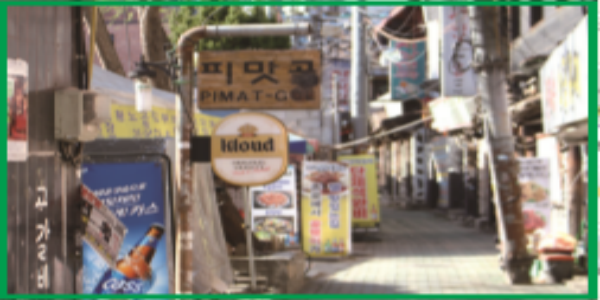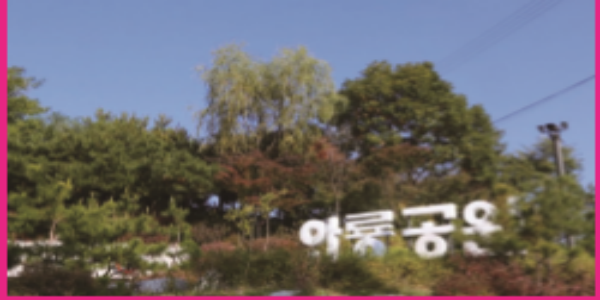May is here, and many Kingos who have now finished their midterm exams will look for places to visit during the vacation. Most of them leave Jongno-gu, the area where the Humanities and Social Science Campus is located, and go to many other parts of Korea. Jongno-gu, however, is well-known for its long history since there are so many historical sites that show the history of Korea. Therefore, the Sungkyun times (SKT) now introduces historical sites in Jongno-gu area, which are not that well-known to Kingos, historical facts related to the sites, and provides a travel guide using the town bus so that readers can actually travel to the sites with ease.
People-Centered Master Class City, Jongno-gu1
Jongno-gu, as the center of Seoul for the last 600 years since the transfer of the capital city to Hanyang during the Joseon Dynasty, has played an important role at the heart of Korean culture. The name Jongno originates from the bell tower which was built to let the people know of the opening and closing hours of the Doseongmun Gate located at Jongno 1(il)-ga. Jongno-gu has a long history and, therefore, is home to various cultural assets including Bugak and Inwang Mountain, Gyeongbok and Changgyeong Palace, Jongmyo Shrine, Sajikdan Altar and Dongdaemun. Additionally, with its well-preserved traditional hanok, Korean traditional houses, and many modern places such as Daehak-ro, Jongno-gu is a symbol of balance between tradition and modernity.
How Much Do You Know About Jongno-gu?
Later SKT will introduce several of the most recommended historical sites in Jongno-gu. But before that, let’s check how much you know about Jongno-gu. Try taking the quiz below, and then check the correct answers at the back.
Q1. In the drama Guardian: The Lonely and Great God , which was popular this year, the main character Goblin’s house was Unhyeong palace Yanggwan . But, whose house was it in the past?
Q2. In the past, the number of rooms allowed in a palace, the houses of servants, and ordinary people were different. Additionally, the number of rooms of ordinary people was actually limited. What do you think is the maximum number of hanok rooms that the servants and ordinary people could live in?
Q3. According to a myth from the past, Korea began with Gojoseon , which was founded by this person. He was the son of Hwanung , a man from the sky, and Ungnyeo , a woman who was changed from a bear. What is the name of this person?
Q4. In historical dramas and movies, we often see people bow down to high-ranking government officials when they pass through the towns of ordinary people on their horses. What is the name of this tradition?
Now that you’re finished, let’s take a look at some of the best historical places to visit in Jongno-gu.
Jongno-gu History Trip with the Jongno-gu Town Bus!
1. Changsin-dong Cutting Area

•From Myeongnyun Market at the back gate of Sungkyunkwan University’s bus stop, take the Jongno 08 bus ⇨ Get off at Ehwa Sageori (crossroads) bus stop ⇨ Walk about 15 minutes to Changsin-dong Cutting Area
Viewing Point! Look in wonder at the sheer granite cliffs and ‘Bongje maeul (sewing village)’ beneath them!
Ehwa-dong, the inner part of Naksan and the fortress wall, was considered to be one of the five most scenic spots of Hanyang, during the Joseon Dynasty. Additionally, Chang-sin dong, the outer part of Naksan and the fortress wall, was full of groups that served the Naksan mountain god, as well as many fortuneteller houses. This place of faith, however, was developed ruthlessly into a quarry by the Japanese in the early 1900s. The Japanese Empire exploited the granite of Changsin-dong and started to build large-scale western style buildings such as the Japanese Government General Building of Korea to show off their power. After the Korean War, people started to settle down under the quarry and formed a village, which still remains the same. The area was given the name of ‘Bongje maeul’ which means ‘sewing village’ since there are many small sewing shops and a sewing museum. Because of the unique atmosphere that the cutting area and Bongje maeul have, Changsin-dong appeared as the location for the drama Secret Garden and the movie Architecture 101.
2. Tangun Shrine

•From the Changsin-dong cutting area, walk to Dongdaemun bus stop for 12 minutes ⇨ Take green bus number 7025 ⇨ Get off at Sajik stop ⇨ Walk to Tangun Shrine for four minutes
Viewing Point! Tangun Wanggeom, who we only hear about in the birth myth of Korea, is worshiped in the shrine!
According to the myth of Korea’s birth, Korea was founded by Tangun Wanggeom, the son of a man from the sky and a woman who was changed from a bear. At the Tangun Shrine, there is a big portrait and a statue of Tangun Wanggeom. This place is meaningful in that it was the first shrine that served Tangun Wanggeom in Korea. Additionally, the ceremonies celebrating Uhchunjul, which is the day Tangun died, and Gacheonjeol, the national foundation day of Korea, are held every May 15th and October 3rd respectively. These ceremonies are held to thank Tangun for founding the country.
3. Pimatgol Alley

•From Tangun Shrine, walk to Sajik bus stop ⇨ Take the blue bus number 606 ⇨ Get off at Jogyesa Temple bus stop ⇨ Walk five minutes to the entrance of Pimatgol
Viewing Point! Visit the old town and its alleys and try various foods from the hidden delicious restaurants!
‘Pima’ was the custom that the people of the Joseon dynasty observed by bowing down to high-ranking government officials when officials passed through the town of the ordinary people with their horses. It was very tiresome for passengers because they had to stop to bow every time officials passed through the town. Therefore, to save their time and avoid discomfort, the people passed through narrow alleys, not the main street that the officials usually passed along. As people repeatedly used the narrow alleys, many restaurants started to flourish, and have remained there at Pimatgol until now. Pimatgol was originally formed from Jongno 1(il)-ga to Jongno 6(yuk)-ga, but because of the redevelopment project of Seoul, only a small part remains from Jongno 2(i)-ga to Jongno 6(yuk)-ga.
4. Unhyeongun Royal Residence
•From the entrance of Pimatgol walk to Jonggak station YMCA bus stop for a minute ⇨ Take the Jongno 01 bus ⇨ Get off at Unhyeongung bus stop ⇨ Walk to Unhyeongung for two minutes
Viewing Point! See the harmony of the Hanok of the Joseon Dynasty and the western-style houses of the Japanese colonial era, as well as the life of Empress Myeongseong and other family that are reenacted in some parts of Unhyeongung.
Unhyeongung was a house of Heungseon Daewongun, who was the father of the 26th king of the Joseon dynasty, Gojong. When Heungseon Daewongun wielded power as the practical king instead of his young son, all discussions about political affairs were made at Unhyeongung. Until now, it was left just as it was in the Joseon dynasty, since it was never destroyed. Additionally, there is a western-style building just outside of Unhyeongung. It is Unhyeongung Yagnggwan, which is now used as the Lifelong Education Center of Duksung Women’s University. This building is also the most well-preserved western-style building and was used as a location in Guardian: The Lonely and Great God.
5. Anguk-dong Yun Posun Residence

•From Unhyeongung, walk to Unhyeongung bus stop for two minutes ⇨ Take Jongno 01 bus ⇨ Get off at Anguk station exit no.2 bus stop ⇨ Walk to Yun Posun residence for five minutes
Viewing Point! Take a look at the only nobleman’s hanok in Seoul that has remained there for 140 years!
Anguk-dong Yun Posun residence was the house of Yun Posun, the fourth president of Korea. It was built in about 1870, and has 99 rooms, which is the maximum size of a house that the people could live in at the time. The most special point of the Yun Posun residence is that it has remained in exactly the same position for the past 140 years, since most hanoks of the people in Seoul were built in about the 1920s as a part of a housing development project or were relocated from other cities. Furthermore, Yun Posun residence is a good example of a historical building which can help people to understand the transition process of the style of architecture because it includes Korean styles and western styles together.
6. Waryong Park

•From Yun Posun residence, walk to Gaheodong community service center bus stop for four minutes ⇨ Take Jongno 02 bus ⇨ Get off at Waryong park, the back gate of Sungkyunkwan University bus stop
Waryong Park is a park formed along the fortress of Seoul. Even though it is not a historical site like the ones that have already been introduced, it is the best place to finish the trip. From here, people can take a look at the view of Jongno-gu all at once. As this is the end point of the historical trip, take a look at Jongno-gu and the whole of Seoul before heading back to campus.
Maybe you might be familiar with some of these places already, or perhaps you have not even heard of them. In Jongnogu, there are many places worth visiting; some of them well-known like Gyeongbok Palace, and some of them more unfamiliar like those that SKT has introduced. At this time of year, the SKT hopes that Kingos will consider exploring Jongnogu once and have a special time near our Humanities and Social Science Campus.
